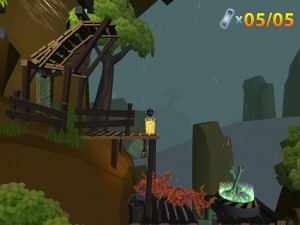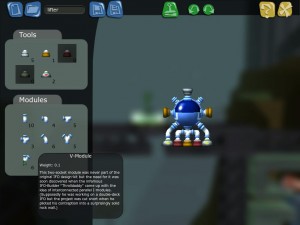Bob Came in Pieces
 Bob Came in Pieces is a charming indie physics puzzler, 2D but with 3D decorations, short enough to play to its conclusion in a single lazy Saturday. The basic idea is that you control a crash-landed alien spacecraft with Lunar Lander-like controls, and you have to find and reattach the bits that fell off in the crash so you can use them to solve various mechanical puzzles. When I first heard about this, my first thought was that it must work something like Knytt, each piece you recover representing a power-up that gives you a different special ability. But in fact it’s simpler and more complex than that. The majority of the pieces you collect are purely structural, like legos or tinkertoys: various shapes of socketed strut that let you reattach your rocket engines in different ways. Or sometimes not even that: sometimes all you really need is a poking-stick to give a tap to something past a narrow gap.
Bob Came in Pieces is a charming indie physics puzzler, 2D but with 3D decorations, short enough to play to its conclusion in a single lazy Saturday. The basic idea is that you control a crash-landed alien spacecraft with Lunar Lander-like controls, and you have to find and reattach the bits that fell off in the crash so you can use them to solve various mechanical puzzles. When I first heard about this, my first thought was that it must work something like Knytt, each piece you recover representing a power-up that gives you a different special ability. But in fact it’s simpler and more complex than that. The majority of the pieces you collect are purely structural, like legos or tinkertoys: various shapes of socketed strut that let you reattach your rocket engines in different ways. Or sometimes not even that: sometimes all you really need is a poking-stick to give a tap to something past a narrow gap.
And once the tap is delivered, you go back to the building-place and reshape your ship into something sensible, because off-balance structures make you list or even spin in midair. This is where the physics comes in. You can have rockets pointed in any of the eight cardinal directions, and control them independently or in any combination you please — the game lets you assign keys to specific rockets arbitrarily — but how much of their force propels you and how much makes you spin depends on how you place them. Aside from rockets, there are two other sorts of similarly-controlled device: a puller and a pusher, both of which produce beams of directional force. The puller attracts moveable objects to your ship, but also, in accordance with Newton’s Third Law, attracts your ship to them, which can be hard to control until you’ve found enough rockets to counterbalance it. The pusher does the same in reverse, creating a repulsion between objects and your ship. But wait — isn’t that exactly how rockets work? What distinguishes the pusher from a rocket? Well, the pusher only pushes objects that are flagged as moveable. (You can tell them by their green shine.) If you’re not near one, it produces no effect. Rockets always affect the motion of your ship and nothing else. (At least, nothing else directly. Your ship can push stuff.) So this isn’t quite real-world physics we’re dealing with here, but we still have force and weight and momentum both linear and angular.
 You spend a substantial fraction of the game in the ship-building interface, a rather well-put-together UI. It provides the option to save configurations to disk to reload them later, but I was up to level 11 (out of 14) before I took advantage of that. Before that point, most of my redesigns were single-use, designed around a specific puzzle — and besides, I kept getting more useful pieces. But towards the end, additional stuff seemed superfluous, and I spent most of my time with two basic designs. There was the Tiny, a minimal ship for small spaces, and there was the Lifter, which had a wide row of symmetrically-arranged pullers and rockets on its underside. It’s actually a bit of a letdown when you’ve collected so many pieces that you can easily make whatever configuration you want. In the earlier stages, you have to come up with ingenious linkages to use the parts you have, and then hope that the result is balanced enough.
You spend a substantial fraction of the game in the ship-building interface, a rather well-put-together UI. It provides the option to save configurations to disk to reload them later, but I was up to level 11 (out of 14) before I took advantage of that. Before that point, most of my redesigns were single-use, designed around a specific puzzle — and besides, I kept getting more useful pieces. But towards the end, additional stuff seemed superfluous, and I spent most of my time with two basic designs. There was the Tiny, a minimal ship for small spaces, and there was the Lifter, which had a wide row of symmetrically-arranged pullers and rockets on its underside. It’s actually a bit of a letdown when you’ve collected so many pieces that you can easily make whatever configuration you want. In the earlier stages, you have to come up with ingenious linkages to use the parts you have, and then hope that the result is balanced enough.
The puzzles are all about getting access to places. The levels are all essentially systems of tunnels, even if they don’t look like it — in some places there are rows of trees, with their canopies acting as a ceiling. Some of the later levels provide some genuine wide-open spaces, and by that point, you have some high-powered rockets and can go zooming and swooping around like the UFO you are, with a satisfying sense of heart-plunge when you shut off the rockets and go into freefall. (Not that there’s any real danger; there’s no death in this game. Even in the one level that throws fireballs at you, all they do is smack into you and send you backward.) But the puzzles are on the periphery of such large spaces, in tunnels, so that’s where I spent most of my time. The build-it-yourself approach gives the player a great deal of leeway in the details of how the puzzles are solved, but unlike, say, World of Goo, the overall solutions are generally designed rather than emergent. You might, for example, have a platform suspended from a chain with a counterweight, and the counterweight is blocking a passage, so you have to put something heavy onto the platform before you can get past. Occasionally there are alternate routes, sometimes involving hidden passages, which may be the key to passing the time trials (something I have no intention of even attempting). And occasionally it’s even possible to bypass the intended solutions by doing something fiddly and inefficient, but that’s hardly satisfying.
I do like this game overall, but I can’t help but wonder what a different design sensibility could have done with the concept — maybe something that would make me create more than two reusable ship designs. I suppose this means it’s a good candidate for mission packs, fan levels, and/or sequels.
 Comments(0)
Comments(0)